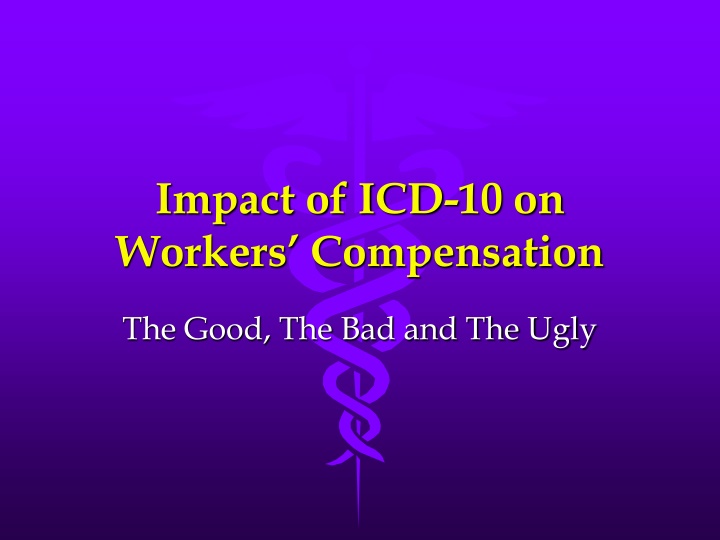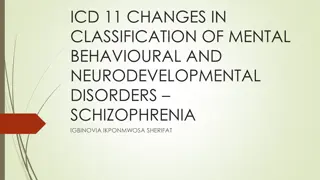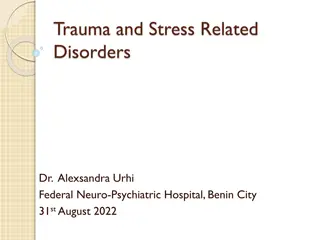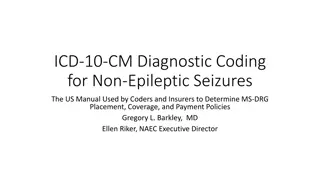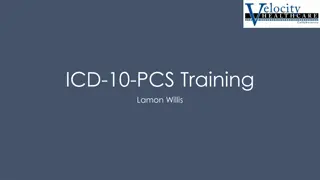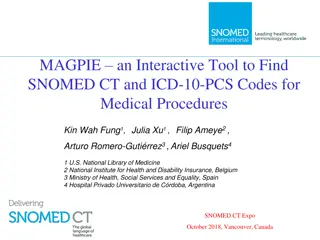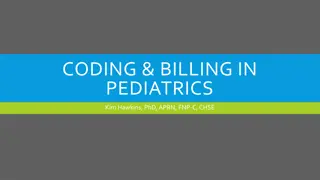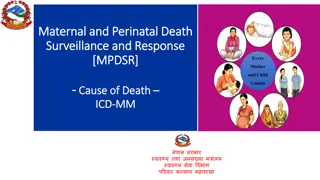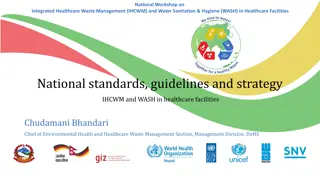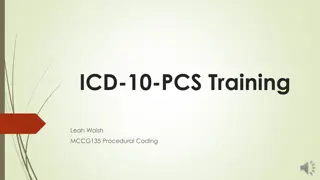History of ICD: Evolution and Impact on Healthcare
International Classification of Diseases (ICD) has evolved over centuries to classify causes of injury and death. Learn about its historical development, diagnostic coding capabilities, and how ICD-10 impacts Workers Compensation case management.
Download Presentation

Please find below an Image/Link to download the presentation.
The content on the website is provided AS IS for your information and personal use only. It may not be sold, licensed, or shared on other websites without obtaining consent from the author.If you encounter any issues during the download, it is possible that the publisher has removed the file from their server.
You are allowed to download the files provided on this website for personal or commercial use, subject to the condition that they are used lawfully. All files are the property of their respective owners.
The content on the website is provided AS IS for your information and personal use only. It may not be sold, licensed, or shared on other websites without obtaining consent from the author.
E N D
Presentation Transcript
Impact of ICD-10 on Workers Compensation The Good, The Bad and The Ugly
Objectives Understand the history of the ICD (International Classification of Diseases) Review enhanced diagnostic coding capabilities and advantages of ICD-10 as it relates to clinical documentation Discuss how ICD-10 impacts Workers Compensation case management
International Classification of Diseases ...diagnostic tool that is used to classify and monitor causes of injury and death and that maintains information for health analyses, such as the study of mortality (death) and morbidity (illness) trends. The ICD is designed to promote international compatibility in health data collecting and reporting. SR Raminani, Britannica Online Encyclopedia
The History of International Classification of Diseases 1600 s and 1700 s First attempts to systematically classify diseases Interest in tracking causes of mortality Childhood illnesses Communicable diseases Of little benefit Inconsistencies in nomenclature Poor statistical data SR Raminani, Britannica Online Encyclopedia
The History of International Classification of Diseases 1800 s Importance of creating a uniform system was realized International Statistical Congress 1853, Paris Organizers request preparation of a uniform classification of causes of death Introduced principle of categorizing diseases by anatomical site Never internationally adopted 2015 ICD-10-CM Code Set SR Raminani, Britannica Online Encyclopedia
The History of International Classification of Diseases 1800 s International Statistical Institute 1893 Adopted first ICD Based on Bertillon s Classification of Causes of Death Jacques Bertillon was a French statistician SR Raminani, Britannica Online Encyclopedia
The History of International Classification of Diseases 1800 s American Public Health Association 1898 Recommended Canada, Mexico, and USA all use the new ICD system Recommended revision every decade to keep ICD up to date SR Raminani, Britannica Online Encyclopedia
The History of International Classification of Diseases 1900 s The ICD becomes increasingly detailed By 1938 the ICD had undergone 5 revisions World Health Organization Established April 7, 1948 as specialized agency of United Nations Mission is to promote international public health Assumes responsibility for publishing the ICD Wikipedia SR Raminani, Britannica Online Encyclopedia
The History of International Classification of Diseases 1900 s World Health Organization Collects international data for epidemiological surveillance and health management purposes Adopts ICD-9 in 1979 for epidemiological purposes United States adopts ICD-9-CM in 1979 Clinical modifications and hospital procedures Used for reimbursement based coding ICD-9-CM never used outside of USA Wikipedia Optum 360 Coding SR Raminani, Britannica Online Encyclopedia
The History of International Classification of Diseases 1983: DRGs link ICD-9-CM codes with reimbursement 1988: Medicare Catastrophic Coverage Act requires physicians to report diagnosis codes using ICD-9-CM on Medicare claims ICD-9 significantly revised in the 1980s and early 1990s 1994: WHO adopts ICD-10 Optum 360 Coding SR Raminani, Britannica Online Encyclopedia
The History of International Classification of Diseases 1983: DRGs link ICD-9-CM codes with reimbursement 1983 1988: Medicare Catastrophic Coverage Act requires physicians to report conditions using ICD-9-CM The ICD-9 significantly revised in the 1980s and early 1990s 1994: WHO adopts ICD-10 Optum 360 Coding SR Raminani, Britannica Online Encyclopedia
The History of International Classification of Diseases 1900 s 1983: DRGs link ICD-9-CM codes with reimbursement 1988: Medicare Catastrophic Coverage Act requires physicians to report conditions using ICD-9-CM The ICD-9 significantly revised in the 1980s and early 1990s 1994: WHO adopts ICD-10 Optum 360 Coding SR Raminani, Britannica Online Encyclopedia
The History of International Classification of Diseases 1995 United States draft of ICD-10-CM made available United States poised to adopt ICD-10-CM to align with WHO and other countries Optum 360 Coding
The History of International Classification of Diseases 1996: HIPAA (Heath Insurance Portability and Accountability Act) enacted Code set standards established under the Administrative Simplification provision of the Social Security Act New code set adoption process falls under legislative controls 2000 s: Legislative delays stall US adoption of ICD-10-CM Optum 360 Coding
The History of International Classification of Diseases January 1, 2013: Version 5010 electronic billing process and format compliance required for all health plans ICD-10 compliance date delays October 1, 2013: DELAYED October 1, 2014: DELAYED October 1, 2015 ICD-10 adopted ICD-11 targeted for release in 2018 Optum 360 Coding
International Classification of Diseases Epidemiologic tool Comprehensive list diseases, disorders and injuries Allows the world to compare and share health information using a common language Monitoring of incidence and prevalence of diseases
International Classification of Diseases Clinical tool Diagnosis coding for reimbursement Analysis of health information for evidenced-based decision-making Observing reimbursement trends Keeping track of safety and quality guidelines
ICD-10 Code Sets ICD-10-CM Diagnosis coding for use in all U.S. health care settings ICD10PCS Inpatient procedure coding for use in U.S. hospital settings
Comparison of ICD-9 to ICD-10 ICD-9-CM Diagnosis Codes ICD-10-CM Diagnosis Codes No Laterality 1) 3-5 digits 2) First digit is alpha (E or V) or numeric 3) Digits 2-5 are numeric 4) Decimal is placed after the third character No placeholder characters Laterality Right, Left or Bilateral 1) 7 digits 2) Digit 1 is alpha; Digit 2 is numeric 3) Digits 3 7 are alpha or numeric 4) Decimal is placed after the third character X placeholders 69,000 codes to better capture specificity Extensive Severity Parameters Extensive Combination Codes to better capture complexity 14,000 codes Limited Severity Parameters Limited Combination Codes
ICD-10 Is More Detailed Than ICD-9 Laterality: left, right and for some codes bilateral is specified Timing of clinical encounter Initial Subsequent Sequela Traumatic vs degenerative conditions More detail captured in unique 7th character for fractures
7th Character in ICD-10 Fracture Codes A - initial encounter for closed fracture B - initial encounter for open fracture type I or II C - initial encounter for open fracture type IIIA, IIIB, or IIIC D - subsequent encounter for closed fracture with routine healing E - subsequent encounter for open fracture type I or II with routine healing F - subsequent encounter for open fracture type IIIA, IIIB, or IIIC with routine healing G - subsequent encounter for closed fracture with delayed healing H - subsequent encounter for open fracture type I or II with delayed healing J - subsequent encounter for open fracture type IIIA, IIIB, or IIIC with delayed healing K - subsequent encounter for closed fracture with nonunion M - subsequent encounter for open fracture type I or II with nonunion N - subsequent encounter for open fracture type IIIA, IIIB, or IIIC with nonunion P - subsequent encounter for closed fracture with malunion Q - subsequent encounter for open fracture type I or II with malunion R - subsequent encounter for open fracture type IIIA, IIIB, or IIIC with malunion S - sequela
Comparison of ICD-9 to ICD-10 ICD-9 821.11 Open fracture of shaft of femur All codes for femur fracture = 16 ICD-10 S72.352E Displaced oblique fracture of shaft of left femur, subsequent encounter for open fracture type I or II with routine healing All codes for femur fracture = 1530 CMS website: What is different with ICD-10?
ICD-10-CM Code Set Organization Chapters Total of 21 chapters Organized mostly by anatomical site Chapter 1: Certain infectious and parasitic diseases Chapter 6: Diseases of the nervous system Chapter 13: Diseases of the musculoskeletal system and connective tissue Chapter 19: Injury, poisoning and certain other consequences of external causes
ICD-10-CM Code Set Organization Subchapters or Blocks Categories (3 characters) Represents one disease or a group of diseases or related conditions Subcategories (4-6 characters) Greater detail of etiology, anatomical site, and severity
ICD-10-CM Code Set Organization Codes Represents the final level that cannot be further subdivided Highest level of specificity
ICD-10 Impact on Workers Compensation Final rule requires HIPAA covered entities to utilize ICD-10 the code sets Adoption not required for non-covered entities Property and casualty insurance Workers' compensation programs Disability insurance programs Most WC insurance carriers are using ICD-10
ICD-10 Impact on Workers Compensation Medicare Secondary Payer Act WC insurers must notify CMS of any workers' compensation settlement involving Medicare-eligible individual WC insurers often asked to reimburse Medicare for injuries or illnesses unrelated to a workers comp claim ICD-10 helpful for WC insurers to specify which injuries they accept responsibility and those that should be paid by Medicare
Purported Benefits of ICD-10 Greater clinical detail and specificity Room for adding up-to-date codes More accurate and detailed clinical reporting Improving the accuracy of claims processing Better tracking of patient outcomes
Purported Benefits of ICD-10 Better outcome studies Improves monitoring of resources for similar diagnoses Improves tracking risk to employees Detecting and preventing health care fraud and abuse Monitoring resource utilization More accurate pattern recognition
ICD-10 Impact on Workers Compensation Measuring the quality & efficacy of care More visibility into patient conditions and services provided Better analyze healthcare quality at the individual and population levels Better assess the clinical care a patient should receive Bowman, Sue E LeonChisen, Nelly. "ICD10 s Impact on Noncovered Entities: Many Reasons Will Lead to Voluntary Upgrades" Journal of AHIMA 82, no.1 (January 2011): 4043.
ICD-10 Impact on Workers Compensation Measuring the quality & efficacy of care (continued) Better assess the quality of care provided by treating physicians Providing better information for calculating payment rates Increase the ability to substantiate the medical necessity of diagnostic and therapeutic services Bowman, Sue E LeonChisen, Nelly. "ICD10 s Impact on Noncovered Entities: Many Reasons Will Lead to Voluntary Upgrades" Journal of AHIMA 82, no.1 (January 2011): 4043.
ICD-10 Impact on Workers Compensation To leverage the advantages of ICD 10 correct diagnostic coding to the highest level of specificity must be performed Whose responsibility will this be? Treating physicians? Physicians office staff? Case managers? Insurance company coders?
External Causes of Morbidity ICD-10 Codes Found in Chapter 20 Start with the letters V, W, X, and Y Used secondary to a code from another chapter Primary code indicates nature of condition Primary code most often from Chapter 19: Injury, poisoning and certain other consequences of external causes
External Causes of Morbidity ICD-10 Codes Detailed information captured Cause: How the injury or health condition happened Intent: Accidental or intentional Place: Where the event occurred Activity of the patient at time of the event Person s status: paid employment, on-duty military, or leisure activity
External Causes of Morbidity ICD-10 Codes Cause of the injury code (examples) Useful W07 Fall from chair W13.3 Fall through floor W17.4 Fall from dock Humorous W55.41 Bitten by pig V96.02 Forced landing of balloon injuring occupant
External Causes of Morbidity ICD-10 Codes Example WC make up
External Causes of Morbidity ICD-10 Codes Intended uses Provide data for injury research Evaluation of injury prevention strategies
Structure of Chapter 20: ECMs V00-V99: Transport accidents V00-V09 Pedestrian injured in transport accident V10-V19 Pedal cycle rider injured in transport accident V20-V29 Motorcycle rider injured in transport accident V30-V39 Occupant of three-wheeled motor vehicle V40-V49 Car occupant injured in transport accident V50-V59 Occupant of pick-up truck or van V60-V69 Occupant of heavy transport vehicle V70-V79 Bus occupant injured in transport accident V80-V89 Other land transport accidents V90-V94 Water transport accidents V95-V97 Air and space transport accidents V98-V99 Other and unspecified transport accidents
Granularity of ECM V35 Occupant of three-wheeled motor vehicle injured in collision with railway train or railway vehicle V35.0 Driver of three-wheeled motor vehicle injured in collision with railway train or railway vehicle in nontraffic accident V35.1 Passenger in three-wheeled motor vehicle injured in collision with railway train or railway vehicle in nontraffic accident V35.2 Person on outside of three-wheeled motor vehicle injured in collision with railway train or railwayvehicle in nontraffic
Granularity of ECM V35 Occupant of three-wheeled motor vehicle injured in collision with railway train or railway vehicle (cont.) V35.3 Unspecified occupant of three-wheeled motor vehicle injured in collision with railway train or railway vehicle in nontraffic accident V35.4 Person boarding or alighting a three-wheeled motor vehicle injured in collision with railway train or railway vehicle V35.5 Driver of three-wheeled motor vehicle injured in collision with railway train or railway vehicle in traffic accident
Granularity of ECM V35 Occupant of three-wheeled motor vehicle injured in collision with railway train or railway vehicle (cont.) V35.6 Passenger in three-wheeled motor vehicle injured in collision with railway train or railway vehicle intraffic accident V35.7 Person on outside of three-wheeled motor vehicle injured in collision with railway train or railway vehicle in traffic accident V35.9 Unspecified occupant of three-wheeled motor vehicle injured in collision with railway train or railway vehicle in traffic accident
Structure of Chapter 20: External Causes of Morbidity W00-X58 Other external causes of accidental injury W00-W19 Slipping, tripping, stumbling and falls W20-W49 Exposure to inanimate mechanical forces W50-W64 Exposure to animate mechanical force W85-W99 Exposure to electric current, radiation and extreme ambient air temperature and pressure X00-X08 Exposure to smoke, fire and flames ..etc
Structure of Chapter 20: External Causes of Morbidity Y90-Y99: Supplementary factors related to causes of morbidity classified elsewhere Y 92: Place of occurrence of the external cause Y 93 Activity codes Used to indicate the activity of the person seeking healthcare Injury or health condition resulted from, or was contributed to, by the activity
Structure of Chapter 20: External Causes of Morbidity Y 93 Activity codes (examples) Y93.0 Activities involving walking and running Y93.2 Activities involving ice and snow Y93.5 Activities involving other sports and athletics played individually Y93.C Activities involving computer technology and electronic devices Y93.G Activities involving food preparation, cooking and grilling
Structure of Chapter 20: External Causes of Morbidity Y99 External cause status Used to ndicate the status of the person at the time the event occurred Examples Y99.0 Civilian activity done for income or pay Y99.1 Military activity Y99.8 Other external cause status
Useful Detail W50 Accidental hit, strike, kick, twist, bite or scratch by another person W50.0 Accidental hit or strike by another person W50.1 Accidental kick by another person W50.2 Accidental twist by another person W50.3 Accidental bite by another person W50.4 Accidental scratch by another person
Not So Useful Detail W56.1 Contact with sea lion W56.11 Bitten by sea lion W56.12 Struck by sea lion W56.19 Other contact with sea lion W56.2 Contact with orca (killer whale) W56.21 Bitten by orca W56.22 Struck by orca W56.29 Other contact with orca
External Causes of Morbidity ICD-10 Codes No national requirement for mandatory external cause code reporting Exceptions State-based external cause code reporting mandate Required by a particular payer Providers encouraged to voluntarily report external cause codes
External Causes of Morbidity ICD-10 Codes Is it obvious why reporting ECM codes is voluntary? Too complicated Difficult to do correctly Difficult to do completely Too time consuming
